
I could feel my heart pounding in my chest and the tightness in my shoulders. We had a lineout near our try line, and I needed to hit the lineout jumpers with my throw, so we could get the ball to our fly-half and clear it. I blocked the negative thoughts, visualised a successful throw, took a deep breath, and threw the ball in.
Matthew, semiprofessional hooker

The physical and mental responses to events that cause us to experience physiological or mental tension are referred to as stress. Experiencing stress can be unpleasant, and stress can negatively affect your performance if you don’t manage it effectively.
Callard the PLAYER

Stress is good; it is the driver that pushes athletes beyond themselves to reach the pinnacles of sporting excellence. I loved it—loved it in training and loved it in matches. Yes, it raised the pulse, gave me a dry mouth, and physically made me shake at times, but it gave me a great indication of where I was as a player. I enjoyed the big games because they didn’t come around that often. They were there to be enjoyed, if you had time.
When we experience stress, we encounter many different sensations. In addition, people vary in the symptoms of stress that they experience. Some of these symptoms are listed below.
• Increased heart rate
• Muscle tension
• Dry mouth
• Increased blood pressure
• Nausea
• Worry
Stress occurs when we perceive that the demands of a particular situation, such as the quality of the opponents in a rugby match, outweigh our personal resources to manage the situation. This circumstance is represented as the seesaw diagram in figure 5.1 (Lazarus, 1999).

In part 1, the demands of the situation and your resources to deal with the stress are similar, so in this instance you would not experience stress. In part 2, your resources to manage the situation are much greater than the demands, so you will experience boredom. In part 3, the demands of the situation are much greater than your resources, so you will experience stress.
Only things that we care about have the potential to cause us stress. For instance, if you don’t care about how well you do in a particular exam, that exam will never cause stress. On the other hand, if you do care about your performance in an exam, you may experience stress if you think that you might fail or if you do actually fail. This idea is supported by a quotation from an international rugby player who described his feelings when making his international debut:
When I played for Wales my first cap was against South Africa, which is one of the best second rows you are going to play against. That was really nerve racking as I sat on the bench thinking, Oh crap, oh God, there are 80,000 people watching you, live TV cameras. I was thinking, I am going against these two awesome guys. I was bricking it when I went on. I was worried about letting myself down. I did not want to miss a tackle, drop the ball. I did not want to do something stupid knowing that all my friends and family were watching. It was live on TV and my first cap and I was really nervous (Nicholls, Levy, Jones, Rengamani, & Polman, 2011, p. 84).
In this situation, a number of factors caused this player to experience stress, such as playing against well-respected opponents, fear of letting himself down, fear of making a mistake, and the match being televised.
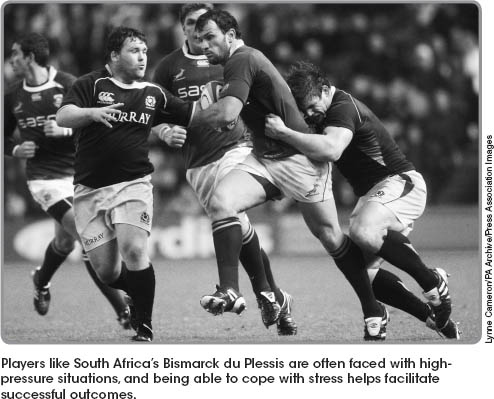

There is a direct relationship between how effectively people cope with stress and how well they perform (Haney & Long, 1995). That is, when rugby players experience stress but do not cope with it effectively, they experience a decline in performance as their stress levels increase (see figure 5.2a). But when rugby players cope effectively with stress, their performance does not decline (see figure 5.2b). Coping with stress is therefore essential to rugby players.
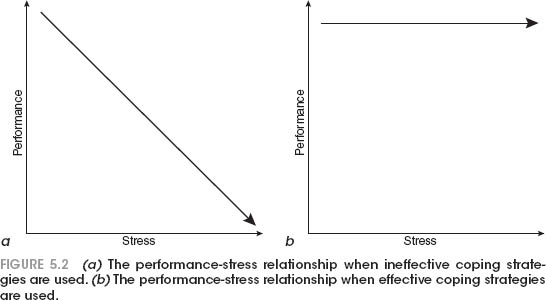
What is coping? Coping refers to the things that we do to manage stress. It is generally accepted that coping comprises two elements:
• Cognitive. Coping that involves mental processes is known as cognitive coping. Strategies include visualisation, blocking out negative thoughts, and wishful thinking.
• Behavioural. Coping that involves physical behaviours such as walking away from a stressful encounter is referred to as behavioural coping.
Callard the PLAYER

I dropped an easy high ball and conceded a soft scrum to the opposition. I calmed myself down by taking a deep breath and making sure that my next touch was positive for the team. It was an easy clearance kick from a spilled attack. I picked my spot and buried it into the stand beyond the halfway line.
Coping effectiveness relates to the degree of success that a coping strategy has in reducing the level of stress that you experience. If deploying a strategy reduces your level of stress, then you are coping effectively, whereas if the intensity of the stress that you experience does not diminish or it increases, your coping strategy is not effective.
Callard the PLAYER

When I had a poor moment, I would stay in control and focus on the next play. There were many moments when I thought I was going to implode inside, but by being focused and making sure that my next involvement was positive, I would get back on track within the game.
To cope more effectively with stress, people should match their coping strategy with the type of stress that they experience (Folkman, 1991). The key to this method of improving your ability to cope is identifying whether you can control the source of stress (e.g., opponents playing well, making a mistake, or the weather). You can directly influence and control some sources of stress, such as your own performance, but you will be unable to control other sources of stress, such as the referee’s decisions. Before deciding what coping strategy to deploy, the first question to ask yourself is, ‘Can I control the source of stress?’ The answer will be yes or no. Then, depending on your answer, you can move on to deploying the appropriate strategy (see figure 5.3).

If you can control the stressor you should use a problem-focused coping strategy (see figure 5.4). This type of strategy aims at reducing stress by solving a problem. For instance, if your lack of fitness is causing you to worry, you can plan a fitness regime, which is an example of problem-focused coping. By not taking shortcuts in your preparation, you can reduce the likelihood or at least the severity of such stressors by being fully prepared (see chapter 3 for more information on preparation).
Alternatively, if the answer is no and you cannot control the stressor, you should use an emotion-focused coping strategy (see figure 5.5). Emotion-focused coping strategies are directed at reducing your emotional responses to stress. For instance, if the weather is making you anxious you could do some deep breathing to calm yourself down, which is an example of emotion-focused coping. Matching stressors to coping strategies is discussed in detail in the remainder of this chapter.
To understand the concept of stressor controllability and the ways in which you have coped in the past, you should complete your own stressor and coping concept maps and then identify controllable and uncontrollable stressors. An example of a completed map of stressors in rugby is presented in figure 5.6, and the coping strategies used to manage those stressors is presented in figure 5.7 on page 60.
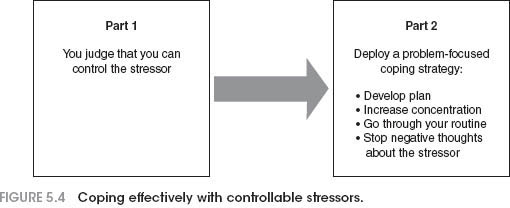
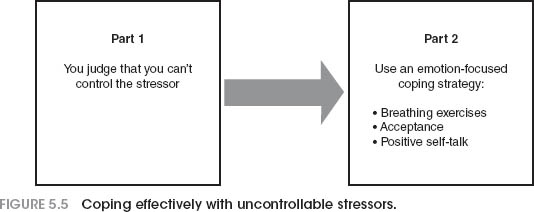
TASK Complete Your Own Stressor and Coping Maps
The stressors listed in the concept map are best managed by the coping strategies listed in the matching numbered boxes of the coping strategies concept map.
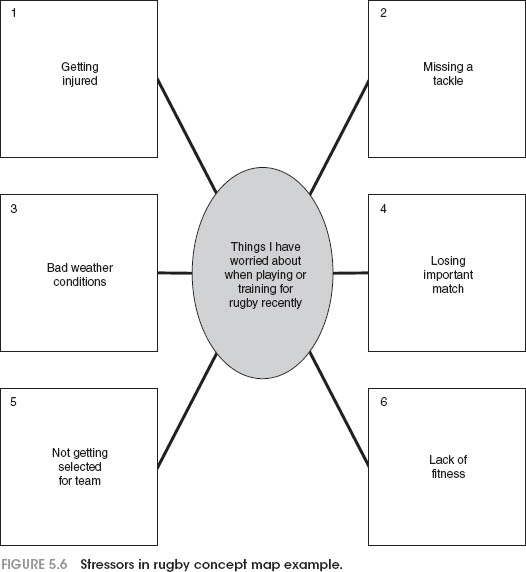
Now it’s your turn. Think about some of the things that you worried about when playing or training for rugby. There are no right or wrong answers. Your opinion is what is important. Describe up to a maximum of six worries in the boxes provided in figure 5.8.

Now try to remember what you did to deal with each of the worries that you have just written down. In box 1 of figure 5.9 write how you managed the stressor that you wrote in box 1 of the stressor concept map. In box 2 write what you did to cope with the stressor that you wrote in box 2 of the stressor concept map. Do this for all the boxes.
The coping strategy that you write in box 1 should be the coping strategy that you used to manage the stressor that you listed in box 1 of the stressor concept map. The coping strategy that you write in box 2 of the coping concept map should be the coping strategy that you used to manage the stressor that you wrote in box 2 of the stressor concept map. This applies for all six boxes of the stress and coping concept maps. For example, in figure 5.6 the stressor in box 1 was “Getting injured.” The coping strategy used was “Wore extra strapping, blocked out thoughts of injury.” In the stressor map the stressor in box 6 was “Lack of fitness.” The coping strategy used, written in box 6 of figure 5.7, was “Did extra fitness sessions.”
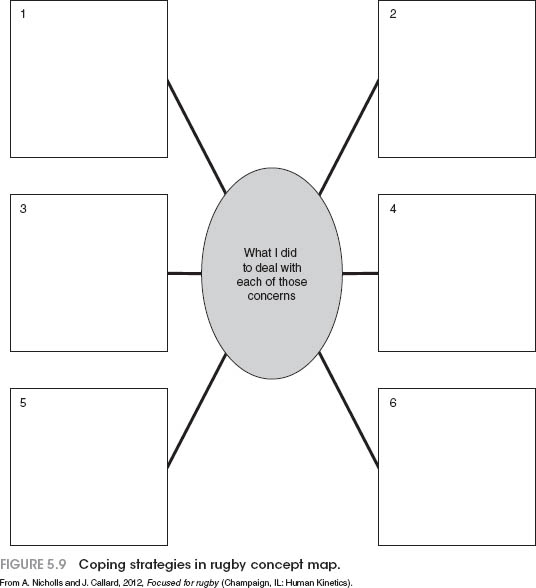
Look at the stressors that you wrote in the stressors in rugby concept map (figure 5.8). Identify the stressors that were directly under your control. A stressor is something that causes you worry, negative emotions, or physiological reactions (e.g., increased heart rate, sweaty palms, muscular tension, nausea, and so on). Table 5.1 lists some sample stressors that are controllable and some that are out of your control.

Remember, controllable stressors are completely within your control and are something that you can influence. List these in table 5.2. If you don’t have five controllable stressors from your concept map, think of other controllable stressors that you have experienced.
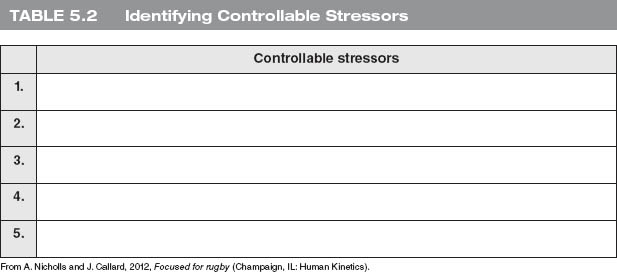
To cope more effectively with sources of stress that you can control, you should use problem-focused coping strategies. Problem-focused coping strategies involve strategies that are directed at solving the problem. When the problem has been alleviated, the stress that you experience disappears. Table 5.3 lists some problem-focused coping strategies that you can use when you can control the source of stress.
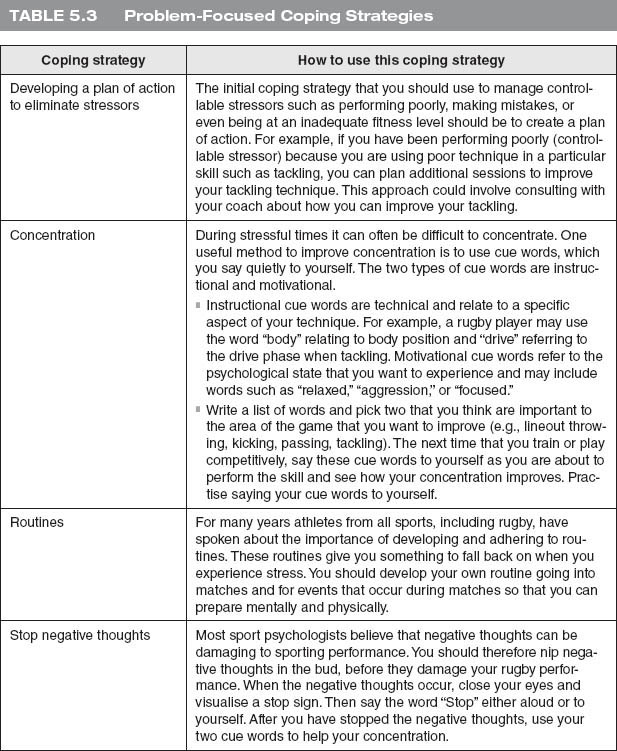
Similarly, look at the stressors that you wrote in the stressors concept map and identify those that you could not control. Remember, uncontrollable sources of stress are not within your control, so you can do nothing to influence them. List those in table 5.4. Think of other uncontrollable stressors if you do not have five uncontrollable stressors from the concept map that you completed.
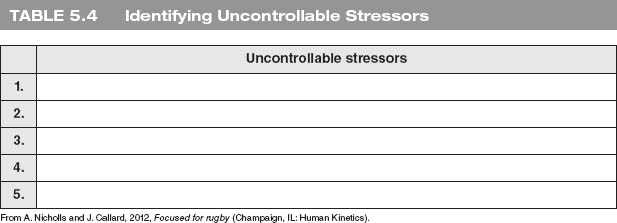
Experiencing a source of stress that you cannot control can be one of the most distressing experiences in sport and life in general. You may feel a sense of powerlessness because there is nothing you can do to manage the stress. In stressful situations such as these, you should use emotion-focused coping strategies. These strategies are directed specifically at managing the emotional distress that you experience whilst playing sport. As such, you are taking control of your emotional reactions to the source of stress, rather than trying to eliminate the stress. Table 5.5 on page 66 shows you a range of emotion-focused coping strategies.
As a rugby player, the people around you are crucial to your success and emotional well-being. These people may include parents, partners, coaches, friends, work colleagues, or children. Anybody who is close to you will have often provided you with support during sport. Certain people that you know, however, will be better at giving you emotional support, whereas others might be better at providing you with problem-solving solutions (see figure 5.10 on page 67). Quite often, the people who are better at providing support to solving problems will not be as helpful in providing emotional support.
Write the names of the people whom you turn to for support during stressful times in your life in table 5.6. Don’t worry if you don’t have five people whom you turn to for support. After you have listed the names of these people, put an “e” beside the person’s name if he or she is good at providing emotional support and put a “p” beside the person’s name if he or she is good at solving problems. To maximise the support that you receive, speak to the people with an “e” beside their name for problems relating to emotional difficulties and speak to the people with a “p” beside their name when you need advice on solving problems.
All rugby players will use or have used ineffective coping strategies. Research indicates, however, that athletes are often not aware that what they are doing is ineffective. The most ineffective coping strategies are presented in table 5.7 on page 68.
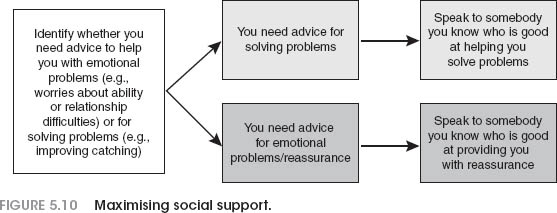
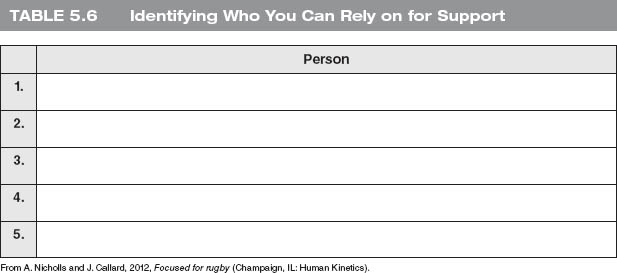
Be aware of these ineffective coping strategies, but do not fall into the trap of using them during stressful times, no matter how tempting it may be to make no attempt to cope, to force your play, to speed up, or to focus on your performance standard or score.

• Stress refers to the physical, mental, or emotional responses to events that cause physiological or mental tension.
• There is a direct relationship between how effectively you cope with stress and how well you perform.
• Coping is more effective if you match the coping strategy that you use to the stressor that you encounter.
• When you can control the stressor, use problem-focused coping strategies such as developing a plan, increasing your concentration, going through your routine, or stopping any negative thoughts.
• When you can’t control the stressor, use emotion-focused coping strategies such as breathing techniques, acceptance, and positive self-talk.